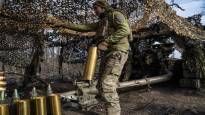Russia intends to resolve the war in Ukraine by the summer, believes a specialist researcher at the National Defense University Pentti Forsström.
According to him, during the spring Russia will make a significant attack that will change the course of the war and Ukraine will be forced to negotiate a ceasefire or even peace.
– I justify this by the fact that Russia cannot be involved in a frozen conflict by itself. This [sota] eat them all the same. War is a problem for them, there’s no denying that.
A frozen conflict refers to a long-term, low-intensity war, which is what the war in Ukraine threatens to become, unless one of the parties wins.
Forsström believes that Russia is constantly preparing its attack by depleting Ukraine’s forces.
When looking at, for example, the one depicting the war situation Deepstatemap we see that Russia is constantly making attacks along the front.
Ukraine is forced to use its dwindling forces to stop the attacks. At the same time, Russia feels where Ukraine’s defense is weak.
It is known that Ukraine’s manpower is constantly being used up, because there are few reserves. The troops who have been at war for two years are starting to get tired.
– This maintenance of combat contact along the front means that Ukraine will not be able to rest its troops in any way. They are more or less caught up in the fight all the time. That’s what consumes, Forsström says.
At the beginning of the week, the Ukrainian parliament passed a decision on the new conscription law, which is hoped to bring more soldiers to the front. However, the training takes months, so additional strength would be available at the end of summer at the earliest.
Russia also needs more men
Specialist researcher Forsström estimates that even Russia’s current strength is not enough for a massive attack, but that it needs more men. He believes that Russia will do some type of mobilization during the spring to increase its military strength.
According to Forsström, there are two options for this. The first is to extend the service period of the current conscript age group or to recruit them as contract soldiers. The current age group is about to be released from service and a new one is joining the ranks.
Another option is a separate mobilization, where reservists would be called into service.
The problem here is that there would be little time to train new troops. The result would be a lot of losses.
According to Forsström, this would not move the Russian leadership much.
– There would be more or less losses, but would it really matter?
The number of vehicles in Russia is astonishing
Ukraine is completely dependent on foreign weapons. Their deliveries have decreased significantly during the winter and spring. For example, the anti-aircraft missiles of the Patriot and Iris-T systems are said to be practically exhausted.
Germany and Norway have promised to supply Ukraine with new anti-aircraft systems, but they will not be delivered until next year or the year after.
The large aid package proposed by the US Democratic Party has been stuck in Congress due to internal political bickering.
Russia has also exhausted much of its most modern weaponry, but has smoothly transitioned to using older weapons.
Russia is launching a large number of aerial bombs equipped with winglets and a simple control system at Ukrainian positions. These destructive bombs are launched from airplanes up to 70 kilometers away, i.e. beyond the reach of close-in air defense.
In February, Ukraine destroyed no less than 13 Russian aircraft launching flying bombs with Patriot missiles. At that time, however, the Patriots were exposed to Russian Iskander missiles and had to be pulled further from the front, says The Conversation news website. Now the Patriot missiles are running out.
Forsström says he is amazed by Russia’s large inventory of tanks. Even though Ukraine has destroyed wagons by the thousands, they just seem to be enough.
‘s military expert Marko Eklund says that when the Soviet Union collapsed in the early 1990s, the armed forces were reduced and a huge amount of used tanks were stored in Russia. The oldest of them were even from the 1950s.
Now renovated and modernized wagons are brought to the front. Although they are old, they work.
Pentti Forsström thinks that Russia’s goal is to weaken Ukraine’s national economy. Of course, it is already doing that by constantly destroying, for example, Ukraine’s energy production.
He presents two options for the direction of the spring attack. The first would be the city of Kharkiv, which is an important concentration of military industry. Russia has bombed the city violently all spring.
Another option is to conquer the Black Sea coast. This would cripple the Ukrainian economy.
These attacks could be supported, for example, by a flanking attack in the direction of Kiev.
Ukraine has not been beaten
According to experts, Ukraine now needs military help quickly.
However, Marko Eklund points out that Ukraine has by no means been beaten yet. For example, the strikes in Ukraine continue to generate large profits for Russia daily crew and equipment losses.
Eklund also considers it clear that Russia will not leave the war unfinished. It has declared that large parts of Ukraine belong to it. It would therefore be humiliating for Russia to state that the goal was not achieved.
In particular, Russia will not give up Crimea easily, and especially not voluntarily, Eklund stresses.
– After all, it has already been immortalized even on the 200 ruble banknote published in 2017.
Source: Reuters
